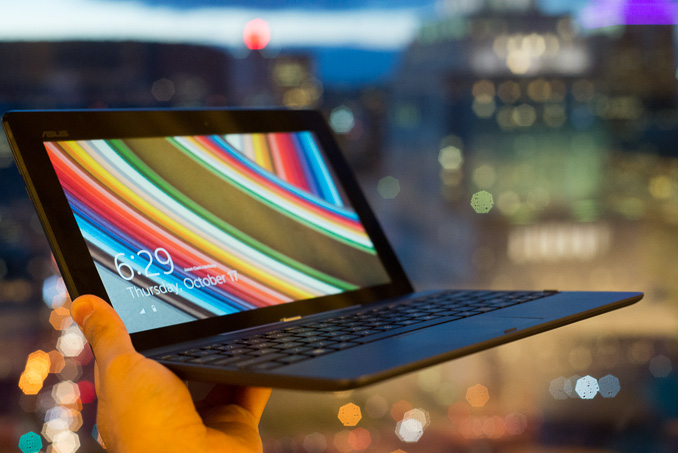ASUS Transformer Book T100 Review: Redefining the Entry-Level Windows Notebook
by Anand Lal Shimpi on October 18, 2013 12:00 AM ESTFinal Words
It’s tough to sell an entry-level Windows PC these days. You’re sandwiched between a couple of aggressive price points: the Nexus 7 at $229 and the iPad at $499. Traditionally, the PC you’d get between those price points would have mechanical storage, the cheapest of cheap TN panels, be bulky as possible, an unimpressive keyboard/trackpad and have 2.4GHz-only WiFi. About the only solace would be that it’d have some insanely quick Core architecture CPU inside, which more or less didn’t matter since the overall experience was hampered so much by the spinning disk inside. Thankfully, times are changing.
Assault first and foremost comes from Google’s latest lineup of Chromebooks. The HP Chromebook 11 addresses many of these concerns but with a fairly limited OS and silicon that’s honestly a bit too slow, even for the target market. But you do get an awesome keyboard, eMMC based storage, and an IPS panel among other things.
The Transformer Book T100 is really the Wintel camp’s answer to the Chromebook onslaught. Compared to the traditional entry-level PCs out there, the T100 really is a breath of fresh air. You get an IPS panel, great battery life and modern WiFi all in a package that can work as both a notebook and a tablet. The system is responsive and predictable in its performance thanks to the use of solid state storage. While there isn’t a full blown SSD inside, the eMMC solution is clearly better for light consumer workloads than a mechanical disk. Solid performance from the rear facing speakers and excellent portability round out the T100’s package. If I had to compare it to what you’d normally expect to get from a $349/$399 Windows PC, I’d say the Transformer Book T100 is a clear winner.
Where things get complicated is if/when you start comparing across platforms. ASUS and Google set the standard for affordable color calibrated displays with the 2013 Nexus 7, and unfortunately the T100 comes no where close to that. Even HP’s Chromebook 11 delivers a more accurate out of box experience than the T100. Again, the T100’s display isn’t bad, it just desperately needs a factory calibration.
It’s important to keep the T100’s performance in perspective. For light multitasking or single app-use workloads, the T100 does very well (much better than the Chromebook 11 we just reviewed). Light browsing and document work are at home on the T100. Don’t expect it to be a Haswell replacement though. I would like to see the gap narrow between Intel’s Atom and Core lines, but I’m afraid it’s going to take real performance pressure from a competitor before we ever see that day.
The dock experience on the T100 is reasonable, but it’s clear to me that the Transformer Book T100 is first and foremost a tablet, and only serves as a clamshell device as a secondary function. That’s not to say it makes for a bad notebook experience, it can just be cramped as a result of the 10.1-inch display footprint. If you’re looking for a device that you’ll use mostly as a tablet but want the flexibility of turning it into a notebook when you need to, the T100 can definitely fit the bill. If your desire is primarily for a touchscreen notebook, then the T100’s tradeoffs may be more frustrating.
At the end of the day the T100 is a good device, but like the Chromebook 11 we recently reviewed it could’ve been amazing with a few tweaks. With a less reflective display, color calibration at the factory and a better feeling keyboard/trackpad I’d be absolutely in love with the T100. I also wonder if 10.1-inches is the right form factor for this sort of a device. I’m not sure that Microsoft’s decision to go with 10.6-inches is the right one either, but the typing experience on a Surface’s type/touch covers does feel remarkably less cramped.
The T100 truly lives up to the Transformer brand. The combination of Intel's Bay Trail silicon and ASUS' mechanicals gives the device a dual personality. In tablet mode it's just as portable as any other 10-inch tablet, while in clamshell mode it can be a netbook-style ultraportable PC. I’d love to see ASUS continue down this path and truly try to perfect the device. I look at the work that ASUS and Google do together and can’t help but wonder what the T100 would look like if it had the same sort of pressure/influence. Perhaps that’s a bigger criticism of how Microsoft works with its partners, but I look at the comparison of ASUS tablets with and without Google’s influence and try to imagine a further polished Transformer Book. That’s something I’d really like to see.
There are very few perfect computing devices out there, but ASUS is one of the companies with the ability to build one if it really tries.












158 Comments
View All Comments
ACA777 - Saturday, October 26, 2013 - link
Thanks for the fantastic review. I like this device and I'm considering buying one. It's reasonably high quality, addresses a need and is priced right. I won't solely rely on this (just bought a i7 4700HQ laptop), it'll be a good companion to take advantage of the touch screen and long battery life for basic games and videos.vinayshivakumar - Sunday, October 27, 2013 - link
The only shortcoming I see is 2GB of ram. Add 50$ more - throw in a Z3770 + 4GB of RAM + 64GB SSD. That will be awesome...aritai - Sunday, October 27, 2013 - link
Hmm. My Sony VIAO Pro has (Intel's) "Connected Standby" (64 bit Windows8, now 8.1). So I'm not sure there's a 32 bit constraint. Though for 2 and even 4 gbyte machines, 32-bit Windows will have a somewhat smaller memory and disk footprint.I've never been happy with Chrome and touch. Seems a mistake to not evaluate the default configuration "full up" before pointing readers towards alternate setups - esp. since their competitors tend not to have this flexibility. For those who must use Chrome it is good to see that it can be set as the default touch browser.
I also have seen a number of low priced laptops that are claimed to be ultrabooks (or qualify to use the Intel brand) that are pretty impressive even with spinning disks. With the default configurations "sleeping" in response to everything a non-technical user would do to quit using a machine (rather than hibernating or shutting down) - most users see what appears to be instant-on because even these cheap laptops have 4gb or more. And cheap no longer means poor keyboards or touchpads - just because it doesn't cost a lot to make doesn't mean they don't work well (says anyone looking at U.S. manufacturing quality compared to Asian.. where cheap no longer means junk).
azazel1024 - Monday, October 28, 2013 - link
Thanks for commenting on the microUSB functionality! That is awesome to know.rgdave - Monday, October 28, 2013 - link
This is exactly what I've been waiting for. I'm not looking for an 'alternative' to my workhorse laptop (Dell Latitude with all the docking bells and whistles), but an 'adjunct'. I want something really light I can take on short trips, and not haul a laptop, albeit a 5 pound one. I've had an Acer A500 tablet for 2 years, and it's functional for email and web browsing, and great for watching movies on a plane. With Touchdown, it even connects well to Exchange. But with my work, I occasionally need X86 Windows programs, like Dreamweaver, when I need to make an on the run change to a web page, for example. I really don't care if it's slow, as long as I can do it. I'm nervous when I don't have my laptop with me, just in case I need an old reliable Windows program.For me, this is a perfect adjunct. At $399, it's almost a throw away buy. I only plan to use it a few weeks a year, when I'm on the road. The fact that it can also be a 1.2 pound tablet for couch surfing is a bonus. 64G storage plus 64G microSD is fine, because most everything I work on is now stored in the cloud. The USB port offers plenty of extra storage for movies on a thumb drive.
I've been waiting for the new Nexus 10 tablet to come out, because I've been looking to upgrade to a faster and lighter Android tablet. But when I found out about this, my money is moving to the Asus T100. I think Asus has hit a home run with this.
mfm - Wednesday, October 30, 2013 - link
How will T100 stack-up against Acer TZ1810 in term of productivity?buzzerbeeser - Friday, November 1, 2013 - link
"I was sampled a 64GB model (using a SanDisk eMMC controller). Around 30GB of the device's storage was free at first boot (total partition size = 49GB, ~30GB free for additional apps/data)."So exactly how much space is left for my files when I get the 32GB model??
geekfoo - Friday, November 1, 2013 - link
well YOU might be asked to pay $350 dollars (including taxes ?) but in the UK we are asked to pay £349.99 for instance http://www.dabs.com/products/asus-transformer-book...with No Ethernet, No 11AC (or even 2x2 mimo N), and especially NO Intel AVX(2) SIMD not to mention 4th Generation Intel® Core™ Processor with Intel® Iris™ Pro Graphics 5200 for a mass produced 2014 retail produce is a no go , an 11.1" pad would be fine too OC for that price
Khuva - Sunday, November 10, 2013 - link
U didnt even say a single thing about the USB3.0 port, thats even one of its biggest advantage!!mythrocks - Monday, November 11, 2013 - link
Anand, thanks for this review (and for that of the reference Bay Trail tablet). I'd be very keen on reading your review of the Dell Venue Pro 11 (Bay Trail and i3/5). Is such a review on the cards?